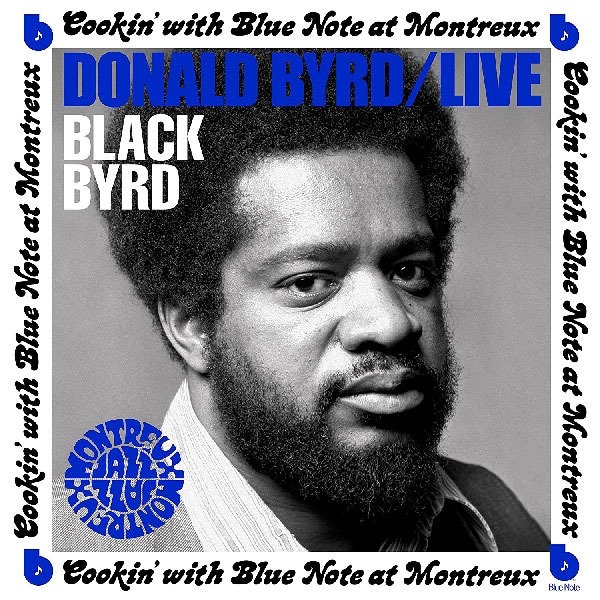| Columns Retired Columns & Blogs |
On my 'buy list!'

The increasingly rare exceptions are to be celebrated. Here's one. Just before the year turned to 2023, on what would have been Donald Byrd's 90th birthday, a smoldering, untapped artifact surfaced after 50 years in the can. Released on reasonably transparent, though disappointingly thin, 160gm vinyl pressed at Pallas in Germany, Donald Byrd Live: Cookin' with Blue Note at Montreux is a perfect example of why hope burns eternal among the musically obsessed and why that hope is justified. It's why fans who already have everything that's been officially released, plus a few bootlegs, still slaver for the hidden, the unknown—anything that will get them closer to a favorite musician's heart and soul.
In the early 1970s, after years of top-shelf bop followed by post-bop jazz, trumpeter and Blue Note stalwart Byrd, who by then was teaching at Howard University, decided to reinvent himself.
By 1973, funk was on the rise, ignited by the inimitable James Brown and stoked by Earth Wind & Fire, Kool & the Gang, and George Clinton's iridescent Parliament Funkadelic universe. The sibling production team of Larry and Alphonso ("Fonce") Mizell, who were instrumental in writing hits for Motown Records including the Jackson 5's "ABC," teamed with Byrd in 1972 to produce Black Byrd, the trumpeter's first album pointed in a funkier new direction. The change ruffled the feathers of some purist Byrd fans. Accused by that angry minority of selling out, he plunged ahead anyway with, between 1972 and 1976, a string of fast-selling, immensely popular albums: Street Lady; Stepping into Tomorrow; Places and Spaces.
The chief reason Live at Montreux is important is that Byrd is heard proving how potent and ahead of its time his unique mix of funk rhythms with jazz instrumentation—known today as soul jazz—was in light of what would come. It's the confidence and obvious belief in this new direction—not just by Byrd but by all the musicians present—that makes this concert so spirited and electric. Much like Miles Davis when he went electric and, later, collaborated with hip hop artists, Byrd's approach was simple: Set up a ferocious groove and let the horns solo over the top. From the opening synth throbs of "Black Byrd," all the musicians are on the same page. The solos are inspired, there are impromptu bits of chanting, and the rhythm section is unstoppable.
Byrd's funky period is credited as the basis for the acid jazz genre that rose in the 1990s, as much of what was recorded then is lighthearted, deeply rhythmic, and fun, a term not often used to describe much jazz from the last few decades. There's plenty of fun on offer here.
What's most magical is the interplay of the 10-piece band. At its heart are four of Donald Byrd's students from Howard—Allan Barnes (saxophone), Kevin Toney (keyboards), Barney Perry (guitar), Keith Killgo (drums)—who went on to form The Blackbyrds, a group that was a huge influence on hip hop and electronica artists including Tupac Shakur, De La Soul, and Massive Attack. Another standout player is bassist Henry "Skipper" Franklin, who recorded his earliest post-bop albums (The Skipper; The Skipper at Home) on the now-revered (and recently reissued) Black Jazz label (footnote 1).
Franklin played on Hugh Masekela's hit single "Grazing in the Grass" and had a varied a career that included playing with such towering jazz legends as Archie Shepp and Pharoah Sanders as well as mainstream soul artists like Stevie Wonder. Finally, both Mizell brothers appear on these six tracks: Larry on trumpet and Fonce on synthesizers. Happily, original engineer Chris Penycate knew how to manipulate recording gear and place microphones: The sound is exceptional for a live album. Both Kevin Gray, the mastering engineer, and Qmillion (aka Keith Lewis), the mix engineer best known for the 2012 R&B Album Grammy Award he won for Robert Glasper's groundbreaking Black Radio, did exceptional work.
As current Blue Note President Don Was writes in a liner note, he was prompted to go digging for the tapes of this gig after receiving an email from UK DJ/label owner Gilles Peterson wondering about a "legendary performance" by Byrd at Montreux. It was the only show not released in what Blue Note called the Montreux Series, which contains live recordings captured that year by Bobbi Humphrey, Marlena Shaw, Bobby Hutcherson, and Ronnie Foster. Was was "knocked out" by what he heard. "The 16-track 2" analog master tapes revealed a more raw and gritty side of Donald Byrd's '70s music."
All of which leads to the question of why this sat unreleased for so many years. I posed that question to the label. No one had a definitive answer. In 1973, as Larry Mizell mentions in his liner note, Byrd's Black Byrd was a big hit for Blue Note, to the point that the regular American Airlines flight to Europe played the album as part of the preflight cabin soundtrack. That fact may hold the key to its long dormancy. Blue Note sources speculate that George Butler, who was then Blue Note's president, didn't release Live at Montreux because he didn't want to get in the way of Black Byrd, which was already doing so well.
Whatever the reason, jazz miracles occasionally do happen.
